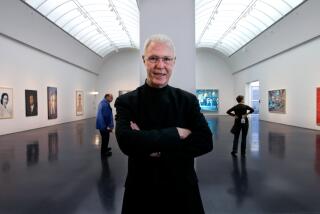A Different Dance of Diversity : Multiculturalism: CalArts’ Cristyne Lawson refuses to choose dancers on the basis of race. ‘We have always been diversified. And we didn’t do it for reasons of mixing cultures. . . .’
- Share via
CalArts, the respected institution founded by Walt Disney, has long been a haven for the experimental arts. It’s produced famous and influential graduates in a variety of disciplines and been at the forefront of a number of trends.
In fact, the school hopped aboard the interculturalism bandwagon back in the 1980s, when mixing it up culturally was just coming in vogue. And since President Steven Lavine took office in 1988, the banner of diversity has been flown even higher. But that doesn’t mean everybody here toes the multicultural party line.
“The whole thing is totally out of hand, silly,” says dance school dean Cristyne Lawson of the art world’s preoccupation with racial and ethnic categorization.
“Don’t get me wrong, I know there’s been a necessity to do it in some areas,” she continues, “but in the world of art you start getting into trouble, because I don’t think that you can define yourself only by your color.”
Such identity politics, says the outspoken former Martha Graham and Alvin Ailey dancer, are limiting, not liberating. “You have to pick yourself out from under that if you go into defining yourself only in terms of your culture,” Lawson says. “Your culture is only one part of who you are.”
And anyone who doubts that this dancer-choreographer walks the walk as well as talks the talk need only look at the CalArts Dance Ensemble. Founded by Lawson in 1979, the group includes artists working in modern and traditional styles, both Western and otherwise.
“Even though we all had different techniques and styles, we had to find a way to work together,” says Lawson of her ecumenical troupe. “It made us create work that was highly unusual.”
The annual CalArts Dance Ensemble Concert presents “The 25th Year Alumni Celebration” Thursday though Saturday in the Walt Disney Modular Theater on the CalArts campus. Dedicated to the five alumni the dance school has lost to AIDS, the concert will feature two premieres and two repertory works--including dances by such CalArts veterans as Susan Rose, Phyllis Gomer, Jacques Heim, Tomas Tamayo, Nanik Wenten and others. Also on the bill will be guest alums performing in dances created by Ensemble members Lawson, Tina Yuan, Lyndon Branaugh and Liz Maxwell.
The professional troupe is, of course, no different from the dance program out of which it originated. “We’ve always had a diversified group of students in the dance school--lots of foreign, minority students,” Lawson says. “At CalArts, compared with other departments, I would say (the level of diversity) is unusual, but it has been the norm for us.”
Yet the students have never been chosen on the basis of demographics. “It has never applied to us,” Lawson says. “We have always been diversified. And we didn’t do it for reasons of mixing cultures or anything remotely like that.”
Instead, the variety has simply proven artistically fertile. “The students who come here with their different backgrounds have made it richer for us without having to do anything but be themselves,” says Lawson. “The minute you start narrowing yourself down to Korean or Chinese or black or whatever choreography, you’re . . . making your world narrow.”
Which also explains Lawson’s disdain for the practice of presenting choreographers grouped together by virtue of their ethnic backgrounds rather than their work. “I don’t think there are any particular guidelines for black choreographers to follow that are any different from anybody else,” Lawson says. “Why don’t you call it ‘white choreographers’?”
Lawson prefers the color-blind approach. Like the school, her ensemble is an international rainbow coalition of artists from an array of backgrounds.
Originally made up only of faculty members, the group has expanded to include students, alumni and other guest artists. “It was started so that I could keep quality faculty here and growing while they were teaching,” says Lawson, who, with 17 years in her post, is the senior dean at CalArts.
What began so pragmatically, though, has grown into a company with a style all its own. “You see it in the concert,” Lawson says. “No one is coming from any particular technique.”
Besides, says Lawson, purists would do well to remember that American modern dance is itself an eclectic genre. “Almost all of modern dance came out of ethnic dance, in the sense that it has used movement ideas that came out of American Indian styles, yoga and Eastern philosophies,” she says.
“There’s an indigenous American modern tradition here, it doesn’t have its roots in European culture.”
The precedent notwithstanding, that’s not to say that there aren’t cultural differences left to be negotiated. “The biggest differences come in how people conceptualize in different cultures and in hearing sound,” Lawson says.
“In a way, hearing has been harder than the dancing,” Lawson continues. “When you start working with electronic music, it becomes culturally difficult for someone who has only heard Chinese music to understand what is being done.”
Yet no matter how much extra work may be required, Lawson feels it’s better to buck the current trend. “If you can use those headings to your advantage, good,” she says. “But most people get stuck in them. You have to be able to see beyond the latest words.”
* “The 25th Year Alumni Celebration,” CalArts Dance Ensemble Concert, Walt Disney Modular Theater, California Institute of the Arts, 24700 McBean Parkway, Valencia. Thursday-Saturday, 8 p.m. $10. (805) 253-7832 or (818) 367-5507.
More to Read
The biggest entertainment stories
Get our big stories about Hollywood, film, television, music, arts, culture and more right in your inbox as soon as they publish.
You may occasionally receive promotional content from the Los Angeles Times.










